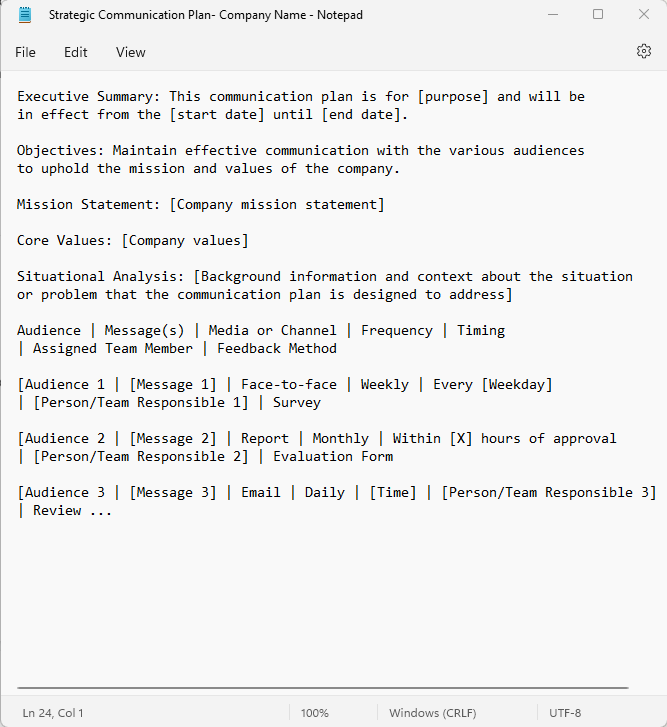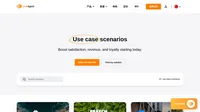沟通计划概述了企业、组织或个人将如何与其内部和外部利益相关者互动,以使他们了解最新的发展。
它包括谁,什么,何时,何地,为什么,以及如何为特定项目或活动量身定制的传播战略和战术。
在这篇博文中,我们将提供沟通计划模板,当您需要向不同的股东传达不同类型的信息时,您可以在自己的业务中使用这些模板。我们还将讨论制定有效沟通计划的一些技巧。
制定沟通计划的重要性
在当今快节奏和不断变化的世界中,当需要时,有一个清晰而简洁的沟通计划比以往任何时候都更加重要。
如果没有一个,企业很容易陷入细枝末节,错过与利益相关者联系的重要机会,或者不能足够快地做到这一点。
沟通计划模板对于各种规模的组织来说都是很有价值的工具。无论您是与您的员工、客户、合作伙伴还是媒体沟通,沟通计划都可以帮助确保您的信息清晰、简洁、切中目标。在这种情况下,如果您需要快速有效地发布公告,模板还可以帮助您构建公告。
如何命名一份沟通计划
这份文件的标题应该反映它的目的,通常(但不总是)意味着包括“沟通计划”和一些具体的细节。这样,每个接触到该文档的人都将知道它的用途,并可以在需要时轻松地引用它。

例如,如果沟通计划是一个新产品的发布或某种营销活动,您可以给它一个标题,明确地说明这一点。标题中可以包含的其他元素包括沟通计划生效的日期以及该计划适用的组织或团队的名称。
在文件主题中包含这类信息将使有关各方了解信息沟通计划,并使每个人都能就何时可以或需要进行某些交流活动达成一致。
沟通计划主题行示例
- 新产品发布沟通计划
- [题目]: 营销活动沟通计划
- [公司名称] 内部沟通计划
- 战略沟通计划: [公司名称]
- [项目名称] 项目管理沟通计划
- 新[公司变更]沟通计划
- 与利益相关者沟通计划:[公司名称]
- [开始日期]-[结束日期]:3月沟通计划
如何写一份沟通计划
沟通计划的启动方式取决于沟通的目的或类型。
有时,以介绍开始是有帮助的,它提供了上下文,并为沟通风格设定了基调,而在其他时候,直接进入沟通目标和策略更有意义。
总的来说,按照下面的步骤来写一份有效的沟通计划会很有用,以确保您的信息击中目标:
对您现有的沟通策略进行审核(如果适用) – 这将让您发现任何需要纳入新计划或更新计划的问题领域或内容缺口(例如缺少营销材料)。
为您的沟通计划定义SMART目标 – 设定具体的、可衡量的、可实现的、相关的、有时间限制的目标将帮助您确定其有效性。
制定组织的使命宣言、核心价值观和关键信息 – 这些应该是所有沟通策略和活动建立的基础。它们也可以在沟通计划中明确指定(例如商业计划书)。
确定您的沟通计划的目标受众群体 – 了解和理解您的信息的接收者会让您更容易为他们设定正确的基调。
决定您的信息将通过哪些渠道传递 – 例如,通过电子邮件或新闻稿来传递给目标受众的最佳方式,会影响沟通计划的撰写方式。
指定负责人 – 决定谁将负责在不同的渠道和不同的受众中传达您的沟通计划。
计算每一步将如何进行,从而计算沟通计划总共将运行多长时间 – 这对于明确时间表和分配预算以提供必要的资源是必要的。
在与相关利益相关者沟通后衡量您的计划的结果 – 认识到需要改进的地方意味着您可以更新您的策略以提高其有效性。
沟通计划中应该包括哪些内容
目的 – 这个具体的沟通计划要达到什么目的
目标受众 – 您的信息的目标受众
日期 – 它是什么时候创建的和/或什么时候这个特定的沟通计划将适用
方法 – 您将通过哪些通信渠道发送消息
角色和责任 – 每个相关方将负责什么任务
做什么和不做什么 – 与项目涉众沟通时的良好实践和要避免的常见错误
升级框架 – 例如,您的“第一道防线”和确定“更大的响应小组”
更新 – 如何以及何时修改文档以保持有效的沟通计划
沟通计划示例和模板
新产品发布沟通计划
[Company Name]: [Product Name] Launch Communication Plan
This communication plan applies to the launch of [Product Name] and is in effect from [start date] – [end date], before and after the launch date of [launch date].
Objectives:
• Ensure that all employees are aware of the launch date and have the necessary information about the product
• Generate excitement and interest in the product amongst employees
• Provide a clear and concise message to customers about the product
• Manage expectations with regards to delivery times and availability
Communication mediums:
• Email
• Press release
• Social media post – [Channel 1], [Channel 2], …
Launch Phases:
• Pre-Launch Activities
• Launch Day
• Post-Launch Follow Up
Pre-Launch Activities ([X] months prior to launch):
• [Activity 1]
• [Activity 2]
• [Activity 3] …
Launch Day:
• Live product unveiling
• Interviews with [Media Outlets]
• Tracking reactions
Post-Launch Follow Up (up to [X] months following launch):
• [Activity 1]
• [Activity 2]
• [Activity 3] …
Roles and responsibilities:
• [Person 1] will be responsible for drafting all communication materials
• [Person 2] will be responsible for sending out communication materials to the media
• [Person 3] will be responsible for handling customer inquiries
Do:
• Create a communication timeline to ensure that all communication activities are carried out in a timely and coordinated manner
• Make use of visuals (e.g. images, infographics) to break up text and add interest
• Proofread all communication materials before sending them out
Don’t:
• Overload stakeholders with too much information at once – provide updates on a regular basis to avoid overwhelming them.
• Forget to include a call-to-action (e.g. visit our website, sign up for our newsletter) in order to engage the reader
• Neglect to test communication materials (e.g. send out a test email) before sending them to the entire list of stakeholders
Framework for escalation:
• If there are any problems with the communication plan, please contact [Person Responsible].
• If [Person Responsible] is unavailable, please contact [Alternative Contact]
Updates:
• This communication plan will be reviewed and finalized on [review date]
• Changes may be made to the communication goals, target audience, and channels
• Updated communication plans should be sent to the [Internal Team/Department Responsible]
[题目]:营销活动沟通计划
[Company Name] will be launching a marketing campaign for [Product Name] from [start date] to [end date].
Goals:
• [Goal 1]
• [Goal 2]
• [Goal 3] …
SWOT Analysis:
• Strengths – [Strength 1], [Strength 2], [Strength 3], …
• Weaknesses – [Weakness 1], [Weakness 2], [Weakness 3], …
• Opportunities – [Opportunity 1], [Opportunity 2], [Opportunity 3], …
• Threats – [Threat 1 ], [Threat 2 ], [Threat 3 ], …
Tactics:
• [Tactic 1]
• [Tactic 2]
• [Tactic 3] …
Channels:
• Email
• Paid search
• Display advertising
• Social media – Facebook, Twitter, LinkedIn, Instagram
• Press release
• Blog post
• Events and webinars – [Event 1], [Event 2], [Event 3], …
Roles and responsibilities:
• [Person/Team Responsible 1 ] will be responsible for drafting all communication materials.
• [Person/Team Responsible 2] will be responsible for sending out communication materials to the media.
• [Person/Team Responsible 3] will be responsible for handling customer inquiries.
• [Person/Team Responsible 4] will be responsible for managing the budget.
Budget:
• $[X] for [Tactic/Channel 1]
• $[Y] for [Tactic/Channel 2]
• $[Z] for [Tactic/Channel 3] …
Evaluation:
• [KPI 1] will be used to measure the success of this marketing campaign
• [KPI 2] will be tracked on a weekly basis and reported to the [Person/Team Responsible]
• [KPI 3] …
Timeline:
• [Activity 1] – [start date] to [end date]
• [Activity 2] – [start date] to [end date]
• [Activity 3] – [start date] to [end date] …
This communication plan will be finalized on [review date] and is therefore subject to change until that date.
[公司名称]内部沟通计划
Objectives: To ensure that all stakeholders are kept up to date with developments, and to keep communication channels open.
Situational Analysis: Internal communication at [company name] has been identified as an area that needs improvement. In particular, communication between management and staff, and communication amongst team members has been identified as needing improvement.
Stakeholders: all employees of [company name]
Implementation:
• A communication plan will be put in place to improve communication at [company name]
• All employees will be made aware of the communication plan and their roles in it
• The communication plan will be reviewed on a regular basis and updated as necessary
Teams Involved: Management team, HR team, communications team
Roles and Responsibilities:
• Management team – responsible for communication with staff
• HR team – responsible for communication amongst team members
• Communications team – responsible for drafting and sending communication materials
Key Messages:
• Effective communication at all times is crucial
• Communication at [Company Name] requires improvement
• This communication plan will be put in place to effect the necessary changes
• All employees have a role to play in the communication plan
• The communication plan will be reviewed on a regular basis
• Communication is a two-way process
• Employees should feel free to ask questions and give feedback
Guidelines:
• All communication should be clear and concise
• Communication materials should be sent out in a timely manner
• Communication channels should be monitored regularly
• Communication should be respectful and professional at all times
Approval: [Person Responsible], [Position], [Creation date]
战略沟通计划:[公司名称]
Executive Summary: This communication plan is for [purpose] and will be in effect from the [start date] until [end date].
Objectives: Maintain effective communication with the various audiences to uphold the mission and values of the company.
Mission Statement: [Company mission statement]
Core Values: [Company values]
Situational Analysis: [Background information and context about the situation or problem that the communication plan is designed to address]
Audience | Message(s) | Media or Channel | Frequency | Timing | Assigned Team Member | Feedback Method
[Audience 1 | [Message 1] | Face-to-face | Weekly | Every [Weekday] | [Person/Team Responsible 1] | Survey
[Audience 2 | [Message 2] | Report | Monthly | Within [X] hours of approval | [Person/Team Responsible 2] | Evaluation Form
[Audience 3 | [Message 3] | Email | Daily | [Time] | [Person/Team Responsible 3] | Review …
[项目名称] 管理沟通计划
Project Name: [Project Name]
Project Manager: [Project Manager’s Name]
Beginning Date: [start date]
Completion Date: [end date]
Project Objectives: Design and build a website and mobile app for the client’s new e-commerce business. Optimize the former for search engine ranking (SEO) and both for conversion, in accordance with [Company Name]’s latest SEO guidelines. Make the website and app user-friendly, mobile-responsive, and visually appealing, including an effective call-to-action (CTA) that encourages users to convert easily.
Communication Goal | Communication Method | Audience | Frequency
[Goal 1] | [Method 1] | [Audience 1] | [Daily/Weekly/Monthly]
[Goal 2] | [Method 2] | [Audience 2] | [Daily/Weekly/Monthly]
[Goal 3] | [Method 3] | [Audience 3] | [Daily/Weekly/Monthly]
新[公司变更]沟通计划
Created By: [Person Responsible]
Effective Of: [start date]
Summary:
• [Change 1] is happening because [reason 1]
• [Change 2] is a result of [reason 2]
• [Change 3] is necessary in order to [reason 3] …
What does this mean for employees?
[Explanation of how the change will affect employees]
Stakeholders:
• [Audience 1] will be impacted by [change 1]
• [Audience 2] will be affected by [change 2]
• [Audience 3] will need to adjust as a result of [change 3]
Phases:
Task | Timeline | Person/Team Responsible
[Task 1] | Day 1/Week 1/start date/etc.] | [Person/Team Responsible 1]
[Task 2] | Day 2/Week 2/mid date/etc.] | [Person/Team Responsible 2]
[Task 3] | Day 3/Week 3/end date/etc.] | [Person/Team Responsible 3] …
与利益相关者沟通计划:[公司名称]
Effective from: [start date] to [end date]
Goals:
• [Goal 1]
• [Goal 2]
• [Goal 3] …
Objectives:
• [Objective 1]
• [Objective 2]
• [Objective 3] …
Changes:
• [Change 1]
• [Change 2]
• [Change 3] …
Projections:
• [Projection 1]
• [Projection 2]
• [Projection 3] …
Stakeholder communication:
• [Channel 1]
• [Channel 2]
• [Channel 3] …
Contact Details: [Person Responsible], [Position], [Phone number/email address/etc.]
[开始日期]—[结束日期]: 沟通计划
Company Name: [Company Name]
Date Created: [creation date]
Contact Information: [contact details]
Introduction:
This communication plan has been created for [purpose] and will be in effect from the creation date.
Objectives:
• [Objective 1]
• [Objective 2]
• [Objective 3] …
Audience:
• [Target user 1]
• [Target user 2]
• [Target user 3] …
沟通计划良好实践
从一个表格或图表开始,确定消息类型 – 您将使用哪种沟通渠道,您的目标对象是谁,语气等等。
在任何交流发出之前,都应该制定一个行动计划 – 最好是积极主动的,在开始活动之前或任何事情出错之前,就为各种信息制定好策略。
包括一个危机沟通计划作为您更大的沟通的一部分 – 更多信息在这里➡️危机沟通计划清单
随着项目的进展,定期检查和更新您的沟通计划 – 事情不可避免地会发生变化,您肯定希望您的信息也能相应调整。
确保沟通团队中的每个人都了解这份文件,并知道自己的角色 – 行动计划的有效性取决于执行这些计划的人
指派专人负责沟通,并确保他们拥有成功所需的时间和资源。
Make your communication top notch with LiveAgent
Our multi-channel ticketing system can help you communicate better and faster. Start your free trial today and experience the benefits.
总结
沟通在任何生意中都是成功的关键,制定一个如何沟通的计划并不一定是一个复杂的过程。
通过遵循模板,您可以写出一份有效的沟通计划,概述在各种情况下您将如何向您的关键受众传达信息。
有了一份写得很好的沟通计划文档,您可以让组织中的每个人都在需要发出什么样的消息、何时以及如何发出的问题上达成一致。
这将使您的消息策略保持一致,并与您的业务目标保持一致,增加实现沟通目标的机会。
Frequently Asked Questions
什么时候应该制定沟通计划?
尽可能快,或者至少在项目或计划的早期,在任何关键活动开始之前。这可以让您思考所有潜在的关键利益相关者,以及如何最好地将您的信息传达给他们。如果您等到项目的后期才制定沟通计划,那么让每个人都接受和参与可能会更加困难。
危机沟通计划有什么不同?
其他类型的沟通计划可用于日常工作,但危机沟通计划是专门为处理重大紧急情况或事件期间和之后的沟通而制定的。危机沟通计划的目标是确保正确的信息及时传达给正确的人,而不管外部因素如何。
我应该多久更新一次我的沟通计划?
一般来说,最好每年至少修改和更新一次沟通计划,以保持其中包含的信息的相关性和准确性,并允许及时进行任何必要的更改或补充。然而,如果组织内部有任何可能影响其沟通策略的重大变化或事件,那么应该尽快更新计划,而不是等待定期审查时间框架。这将使每个参与执行计划的人都意识到任何新的发展或潜在的风险,以便他们能够采取相应的适当行动。
谁能从沟通计划中受益?
个人、团体和企业都可以通过明确沟通的预期结果、指定实现这些结果所需的步骤并确定每个步骤的负责人来改善他们的信息传递。这对那些人或组织,以及将收到信息的利益相关者都是有益的,因为计划将有助于使所有的沟通清晰和简洁,以及防止任何沟通错误或误解的发生。
Explore inspiring success stories of diverse companies using LiveAgent to enhance customer satisfaction, loyalty, and revenue. From global travel agencies like SATUR to innovative startups like FrëschKëscht, discover how businesses thrive with tailored customer support solutions. Start your 14-day free trial today – no credit card required!
You will be
in Good Hands!
Join our community of happy clients and provide excellent customer support with LiveAgent.

我们的网站使用cookies。点击继续我们将默认为您允许我们将cookies部署在我们的网站上。 隐私和cookie政策.

 Български
Български  Čeština
Čeština  Dansk
Dansk  Deutsch
Deutsch  Eesti
Eesti  Español
Español  Français
Français  Ελληνικα
Ελληνικα  Hrvatski
Hrvatski  Italiano
Italiano  Latviešu
Latviešu  Lietuviškai
Lietuviškai  Magyar
Magyar  Nederlands
Nederlands  Norsk bokmål
Norsk bokmål  Polski
Polski  Română
Română  Русский
Русский  Slovenčina
Slovenčina  Slovenščina
Slovenščina  Tagalog
Tagalog  Tiếng Việt
Tiếng Việt  العربية
العربية  English
English  Português
Português 



